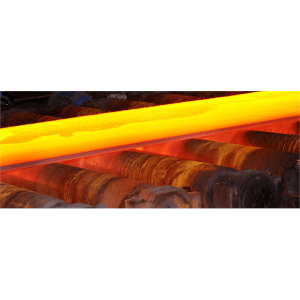
Dimensional control of high temperature metal parts in the steel and metallurgical industry is essential to ensure the manufacture of quality products.
For this purpose, specialized tools such as i laser triangulation sensors, laser distance meters and other instruments based on optical measuring principle.
I laser triangulation sensors provide accurate measurements by measuring the distance between two points with an infrared or visible light source.
These devices are able to detect even very small irregularities in the shape or size of a piece. Laser distance meters are fast, accurate tools used to measure distances between two points on the surface of a workpiece. They use laser beams to accurately measure distances without any human intervention.
Products used

LDM42 series LASER distance meters
- LASER distance meters for distance measurements up to 30 meters on natural surfaces or 100 meters with reflector
- Power supply 24 Vdc
- RS232 - RS422 interfaces - Profinet, Profibus and Ethernet / IP
- Visible LASER emitter (red) with safety class 2
- Accuracy up to +/- 1 mm
- Wide range of accessories for high temperature environments or for environments with high contaminants

LDS10A series LASER distance meters
- Distance sensing without reflector on various surfaces
- Safe operation even in public places thanks to LED lighting (without laser)
- Outstanding price-performance ratio
- One connection cable for supply voltage, serial data interface, switching and analog output
- Personalized parameterization via PC
- Programmable analog and digital interfaces
- Robust and compact housing, easy to install
- IP 67 protection standard
Technical insights
Position measurement is also essential for the production of quality metal parts for steel and metallurgical applications. By comparing the coordinates resulting from a position scan with predetermined values, it is possible to detect position errors on the pieces with a level of accuracy of fractions of a millimeter.
Thickness measurement is also an important factor for dimensional control of metal parts. The thickness of a piece can be measured using sensors a laser triangulation or laser micrometers which can measure up to an accuracy level of 0,001 mm without the need for contact. This ensures fast and accurate measurements without the risk of damaging the piece during the test. Also, most modern tools make use of computerized algorithms to calculate average and punctual thicknesses from a single scan.
In addition, some position measurement systems use computer vision technology to automatically detect the geometric characteristics of complex shapes, such as holes or grooves on the surface of a workpiece, without the need for contact.
La straightness measurement it is also necessary to ensure that metal parts meet quality standards before being used in manufacturing processes or other applications. Straightness measurement involves the measurement of the difference between a reference line and the actual profile of the surface along different intervals of the length of the piece to be tested. Today, several advanced instruments are available that allow you to take measurements with levels of accuracy down to 0,01 mm along lines up to 10 m long, without any user intervention during the entire process.
Width measurement is another important factor when it comes to dimensional inspection, due to its wide application factors in different industries such as steel manufacturing and others where accuracy is paramount. While traditional methods for measuring width involve the use of hand gauges or meters, modern technologies allow for automated measurements that require minimal setup time and provide significantly more accurate results than traditional methods. For example, many laser triangulation sensors feature multi-point scanners that can quickly measure widths at multiple spots over large areas, even at elevated temperatures, with exceptional accuracy.
RODER offers complete solutions designed specifically for dimensional inspection needs when dealing with high temperature metal parts in steel and metallurgical applications.
RODER supplies innovative instruments such as the DIGILEN series, which offer non-contact scanning capabilities and produce precise results even in extreme temperatures, up to 500 degrees
RODER provides advanced equipment such as the Vision System series, with automated visual recognition algorithms that allow you to carry out quick inspections over large areas with little manpower.
The combination of these specialized tools mentioned above helps streamline dimensional inspection processes while improving overall accuracy and efficiency levels. In particular, the unique characteristics of each instrument help to significantly reduce total testing times, while providing reliable results on all types of materials, regardless of the heat treatments applied.
Additionally, many modern systems feature intuitive graphical user interfaces (GUIs) that allow users to easily set up tests and remotely monitor the data obtained throughout the test.
In addition to improving process efficiency levels, these advanced technologies have also helped reduce human error rates through their automation capabilities. For example, powerful industrial computers now control entire dimensional inspection processes, ensuring the reliability of all tests.
Furthermore, sophisticated algorithms incorporated into the latest models allow these machines to quickly identify anomalies in all tested components, thus reducing potential delays during production runs. Finally, capabilities for integration into larger networked systems further enhance data management capabilities, helping companies more accurately track critical production metrics.
In addition, recent advances in software development have allowed manufacturers to create custom programs specifically designed to specific customer requirements, ensuring that each trial produces optimal results every time. In particular, dedicated simulation software packages allow operators to plan test strategies in advance, helping them determine the best courses of action well before the actual tests begin to unfold. In addition, special analysis tools offer users the ability to instantly compare previous tests with the current ones through native dashboards that allow operators to obtain better results